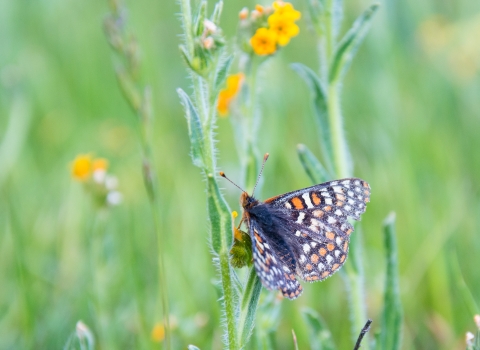LAKEWOOD, Colo. – The U.S. Fish and Wildlife Service (Service) has released a final Comprehensive Conservation Plan (CCP) and Environmental Assessment (EA) that will guide management of the National Elk Refuge (Refuge) in Jackson Hole, Wyoming for the next 15 years. The management decisions included in the CCP are a result of thorough environmental review and input from the local community and other stakeholders.
A draft CCP and EA were released in September of 2014 and underwent 60 days of public review and public meetings. Based on an extensive review of feedback, comments, and internal reviews, the Service has selected a preferred management alternative (Alternative D).
Alternative D is a blended option that would both increase public use opportunities with an emphasis on the six priority wildlife-dependent uses (hunting, fishing, wildlife observation, photography, environmental education, and interpretation) and focus management efforts on promoting natural processes and supporting the Greater Yellowstone Ecosystem.
The CCP and EA are companion documents to the Bison and Elk Management Plan, which provides goals, objectives, and strategies for managing bison and elk on the National Elk Refuge and in the Grand Teton National Park and the John D. Rockefeller, Jr., Memorial Parkway. Therefore, the CCP does not address bison and elk management on the Refuge, including supplemental feeding. Instead, the CCP addresses all other aspects of refuge management including migratory bird conservation, threatened and endangered species recovery, habitat management, visitor use, and management of cultural resources.
Hard copies are available at the refuge administrative offices located at 675 E. Broadway in Jackson. For questions about the CCP/EA, please call 307-733-9212.
Established in 1912, the National Elk Refuge spans approximately 25,000 acres and provides wildlife with a variety of habitat types, including grassy meadows, marshes, forest, sagebrush sagebrush
The western United States’ sagebrush country encompasses over 175 million acres of public and private lands. The sagebrush landscape provides many benefits to our rural economies and communities, and it serves as crucial habitat for a diversity of wildlife, including the iconic greater sage-grouse and over 350 other species.
Learn more about sagebrush , and rock outcrops. Although the Refuge is best known for the largest herd of wintering elk in the world, nearly 175 species of birds and at least 47 mammal species have been observed on the Refuge. A free-roaming bison herd also winters at the Refuge. Each year, roughly 500,000 people visit the National Elk Refuge to enjoy the views and charismatic wildlife.
The mission of the U.S. Fish and Wildlife Service is working with others to conserve, protect, and enhance fish, wildlife, plants, and their habitats for the continuing benefit of the American people. We are both a leader and trusted partner in fish and wildlife conservation, known for our scientific excellence, stewardship of lands and natural resources, dedicated professionals, and commitment to public service.
Connect with our Facebook page at http://www.facebook.com/USFWSMountainPrairie, follow our tweets at http://twitter.com/USFWSMtnPrairie, watch our YouTube Channel at http://www.youtube.com/usfws and download photos from our Flickr page at http://www.flickr.com/photos/usfwsmtnprairie/.



